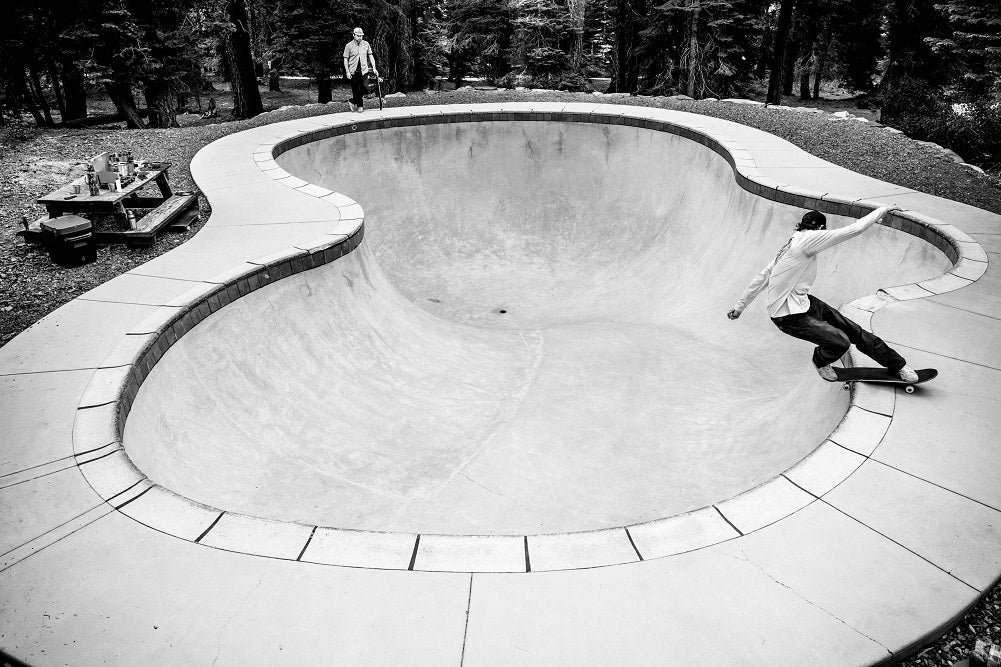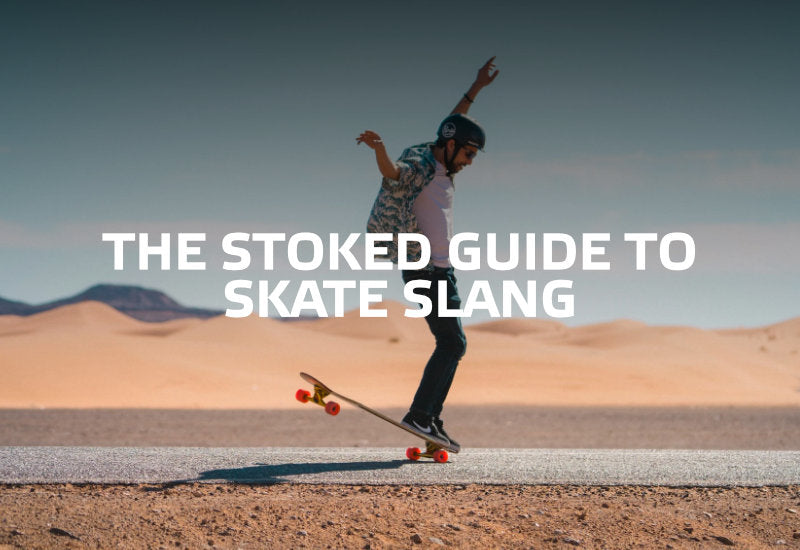Mom just dropped you off and you are finally at the skate park. Congratulations, you are a cool kid now.
But everyone is throwing down terms you just don't understand... You pull out your phone and do a quick search. By the gods of Google, you found this page.
You're welcome, it has everything you need to know about Skate Park Terminology.
Ready to get schooled? Let's start with the ramps.
Parts of the Ramp
There are 4 parts of a skate ramp. These terms are commonly thrown around, so let's get those down first.
1. Transition
A ramp moves a skater from the flat land of every day to the vertical 🤙🏼 The ramp will curve, allowing a rider to make this shift on their skateboard. This transition is called the transition. 🤯
2. Deck
The "deck" refers to two things: the skateboard "made-of-wood-board" part and also the top flat section of the ramp that you can stand on. Extra credit use in a sentence: Skaters stand on deck before dropping in.
3. Coping
This is the rail part of the ramp, where the transition meets the deck. It can come in a few forms including a rail, bar, or just angled section of metal. Most commonly, it is a rail embedded into the ramp.
The coping allows for easier grinds and stalls. It allows the skateboard to "hang up" or "lock in" so skaters can do these tricks more easily.
4. Vert
The ramps with the most extreme transitions will go from flat to vertical. The vertical section of the ramp is the vert section.
Additionally, it is common to refer to an entire subsection of skateboarding as "vert". This is what the X-Games and skaters like Tony Hawk and many others have popularized over the years.
Vert allows riders to get thrown upwards and transition back from the air to the flat without injury (usually).
Types of Ramps
Now that you know all the parts of the ramps, it's time to learn the different types of ramps that you can find out there in the real world.
1. Quarter Pipe
A quarter of a pipe. Ha just kidding, that definition would suck! 😋
A quarter pipe is a ramp with a single transition. It stands alone and can be many sizes, from pretty small to straight vert. If you imagine a full pipe divided into four sections (quarters) then you get the idea.
It can still be called a "quarter pipe" without 4 being able to actually compose a full pipe. Skaters are not that technical.
[Check out how to build a quarter pipe]

2. Half Pipe
Two quarter pipes connected by a flat section. A half pipe allows riders to skate back and forth from coping to coping without leaving the ramp. Many, many tricks can be done on a half pipe.
Most of the time when a skateboarder refers to a half pipe, they are referring to a vert ramp (see #6 - a ramp with vert). However, that is not always the case. See #5.

3. Full Pipe
Half sphere dome structure, usually found in a bowl, that allows riders to go over vert. Riders can ride the entire dome.
4. Cradle
Section above the vert that starts to curve back into the ramp. Most commonly found in bowls. Riders have to hit these with speed as gravity is against them.

5. Mini Ramp
A ramp that is smaller than about 5 ft. Typically mini ramps are too small for a large enough transition to vert.
They are very popular because of the wide range of skill levels that can enjoy them. Pros and beginners alike can get on a mini ramp and have a good time.

6. Vert Ramp
A ramp that has a transition that gets to vert / vertical. These are usually 7ft + to allow for a smooth transition.
Vert ramps are considered artifacts for higher levels of skills. Just to ride a vert ramp is hard, so adding tricks is that much more difficult. However, it is with a vert ramp that you will get the broadest range of trick diversity.

7. Extension
A taller ramp paired to a smaller ramp, with matching transitions. This allows for a different range of difficulty for tricks.

8. Spine / Spine Transfer
Two quarter pipes back to back that usually share a single coping.
These are super fun to skate due to the way riders can transition themselves in the air from one ramp to the other.

9. Kicker / Launch Ramp
These are smaller ramps with the sole purpose of giving riders a full send launch. They can be super small (usually called a kicker) or bigger.
Kickers are commonly easily moveable, so you can use them to hit other skate park paraphernalia.

10. Bank / Wedge
Larger flat ramps that allow for riding. These can be built or found in the urban jungle. A massive range of tricks can be done on banks, from slides to airs.

11. Roll In
The skate park rollercoaster. A roll in is typically a larger ramp with no coping used to get speed before hitting another ramp. They are commonly paired with a half pipe or inserted before a launch ramp to get maximum speed to start a run.

12. Bowl or Pool
The original Z-Boys skated swimming pools in Dogtown and the name has carried over.
Bowls are typically wood built pools in skate parks, specifically for skateboarding. Pools on other handhand are actual pools.

13. Over Vert
Over vert is riding past the vertical section within a full pipe / dome / cradle.

14. Hip
Two kinds of transitions (flat or curved) that meet at a corner.

15. Funbox
A fun element that has a combination of rails, ledges, flats, and banks. They are usually set in between two quarter pipes or banks in a skate park so riders can gather speed before hitting the Fun Box.

16. Pyramid
A 4 sided ramp with a flat section at the top. Usually does not contain mummies.
We also used to call a large and cornered 2 sided bank ramp the pyramid.

17. Volcano
Cylindrical cone shaped element with either rounded or flat top.

18. Nessy
Named after the Loch Ness monster, a Nessy is a curvy ramp that ends in a rollout or kicker like launch. It is good for doing a little pumping before the kicker.

19. Euro Gap
A wedge ramp with a step up on the deck portion. The trick here is gapping the top section to do a stall, grind, or gap.

20. Manual Pad / Manny Pad
A raised flat surface that designates an area to use for manuals. Can be as simple as a plank of wood on the ground or an entire ledge.

21. Grind Box
A box that has edges with steel copings specifically designed for grinding. Edges could be rails or corners. Usually can be moved.

22. Ledge
A grind box that is fixed in place. Can be made of concrete or wood/metal or marble (personal favorite).

23. Hubba
Angled ledge that runs parallel down a set of stairs. Perfect for grinds and slide tricks.

24. Stair
We've all walked on these before and the ultimate urban element for skaters everywhere. Perfect for gapping and all sorts of other tricks. Measured in per step, ie "Did you see him gap that 12-stair?"
Stairs are always counted by the vertical portion of the step.

25. Mega Ramp
Custom built beasts of ramps, usually by pros with lots of cash, these are the ultimate skate ramps.
Mega ramps usually have three elements: 1) Roll in, 2) Kicker and 3) Quarter pipe. The idea is to drop in on the massive roll in to get insane speed for the gargantuan kicker, then shave all the speed going up the fat giant quarter pipe.

Types of Rails
1. Flat Rail
Rail that does not have any angle. It can be flat box like or rounded.
2. Handrail
A rail that is used for people to hold on to while walking, typically running next to a set of stairs. Perfect for grinding.
3. Kinked Handrail
Same as a handrail, but with the added challenge of a bend. The bends can be singular or multiple. More is harder.
4. Rainbow Rail
Curved rail that skaters can grind over the top. These can be into the ground or on fun boxes or mega ramps.
When on ramps, rainbow rails follow the path a rider would naturally follow while using the kicker.
Materials
1. Skatelite
A waterproof skate surface used in the best ramps. This material is designed specifically for the needs of skating.
2. Masonite
More affordable skate surface that is not waterproof. It is good, but will need to be replaced sooner than Skatelite.
3. Skate Paint
Made by OC Ramps, Skate Paint is a special paint used to create an optimum skate surface and ramp protection.
4. Ribs
Usually 2x4s that make the skeleton of the ramp. These span across the ramp to give support to the Skatelite or Masonite.
Closing
That just about wraps up everything you need to know about skate park terminology!
Did we miss anything? Email us at help@stokedrideshop.com
Want to use our images on your project or website? Sure you can! But you must include a direct DOFOLLOW link to this page. Thanks!
Special thanks to Yory Morris for the rad illustrations. Check out her Instagram @yorymorris







![A Pro's Guide to Building a Skateboard [All Essential Parts Explained]](http://stokedrideshop.com/cdn/shop/articles/MaurioMcCoy_BsNoseblunt_Bump2Rail_RRR_Large_6f3b8401-3dd5-4783-9739-7ddaf5cfcf57_1024x.jpg?v=1696896884)
